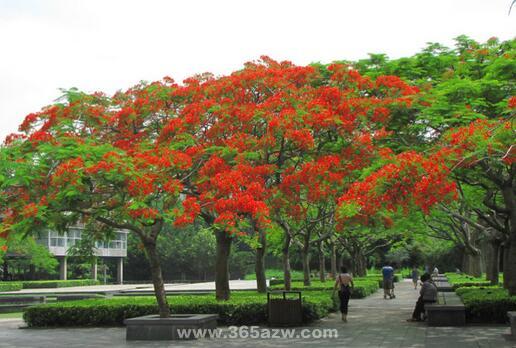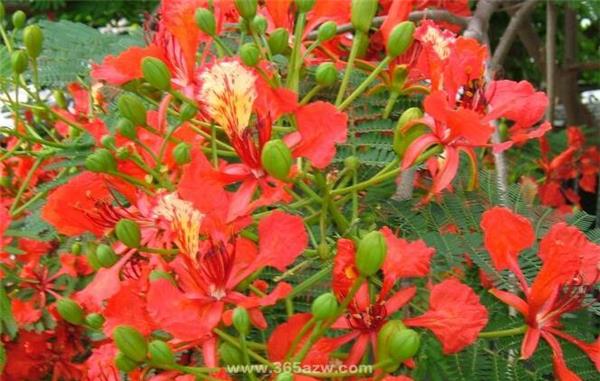The effect and function of Fenghuang wood culture method
Phoenix wood is mostly planted as a courtyard plant, Phoenix wood flowering for a long time, luxuriant flowers, has a high ornamental value. What problems should be paid attention to in Phoenix wood culture? Next, let's take a look.
Brief introduction of Phoenix wood

The medicinal use of Phoenix wood is mainly the bark of leguminous plant Phoenix wood. What does Phoenix wood look like?
Phoenix deciduous trees, 20m or more tall. Bipinnately compound, alternate, 20-60cm long, 30-40 pinnae, 40-80 leaflets per pinna; leaflets long oval, 7-8mm long, 2.5-3mm wide, round at both ends, green above, light green below, sparsely pubescent on both surfaces. Racemes terminal or axillary; calyx 2.5-2.9cm long, basally connate into a short tube, calyx teeth 5, long elliptic, apex abruptly acute; petals 5, red, with yellow and white stripes, suborbicular, long-clawed, with claws 3.5-5.5cm long and ca. 3cm wide; stamens 10, separate, red; ovary subsessile, with many ovules. Pods strip-shaped, up to 50cm long, ca. 5cm wide, pendulous, woody. With many seeds. Flowering in May and fruiting in October.
Cultivation techniques
Seeds are commonly used to sow and raise seedlings. A thousand seeds weigh about 400 grams. The seed coat is difficult to absorb water. It is necessary to use 80 ℃ warm water to scald the seed to promote germination. After natural cooling, continue to soak for 24 hours and drain. When sowing by strip sowing, the seedlings are sensitive to frost, comprehensive fertilizer can be applied in the early stage, less nitrogen fertilizer can be applied, and fertilization should be stopped after autumn to promote Lignification as soon as possible. In winter, if the leaves have not fallen off, they can be cut off manually and covered with film or covered with a single plant to prevent frost. One-year-old seedlings can be planted in the nursery.

Reproduction method
Phoenix wood is mainly propagated by sowing. The seeds matured in December, pods were collected, the seeds were dried and stored, and the seeds were sown in the following spring. Soak the seeds in boiling water before sowing, continue to soak for 1-2 days after cooling, change the water for 1-2 times, germinate 6-7 days after sowing, and produce seedlings in more than 20 days, and the annual seedlings can reach about 1.5 meters.
Cultivation method
The soil should be fertile, deep, well drained and planted in the sun. The seedlings need to be transplanted once after growing for 1-2 years, and the transplanting should be carried out in early spring. When the row spacing is about 60 cm, 3-year-old seedlings can be used for planting. The planting site should be open and sunny, and should be fully watered when the weather is dry. Phoenix wood does not have high requirements for soil, and can grow well in areas with poor soil quality, because its roots have rhizobium and can fix nitrogen and increase soil fertility, but stagnant water will cause the death of rhizobium and affect plant growth. The trunk of Phoenix tree grows branches and leaves at any time, and if it is allowed to grow naturally, the plant shape will change greatly, so it needs to be pruned frequently. Phoenix wood is not cold-resistant, so it can only be cultivated and maintained in greenhouse in the north.

Transplanting to spring germination before the survival rate is high, can also be planted in the rainy season, but to cut off part of the branches and leaves to ensure its survival. The sprouting ability of the plant is strong, and the large seedlings can be cultivated by cutting dry method. After planting, loosen the soil every year, weed 2 or 3 times, timely watering, topdressing in spring and autumn, and remove root sprouting tillers in time to ensure the good growth of the tree.
The Phoenix pest finds insects such as night moths. The insect does harm to the larvae feeding on plant leaves and often eats up the host leaves, seriously affecting the growth and ornamental of trees. Phoenix tree pests are the most severe in July, August and September. Spodoptera litura is not harmful to the human body, but some people will have allergic symptoms.
Prevention and cure method
Seize the period of larval mass damage and spray powder before the dew is dry in the early morning. 2.5% trichlorfon powder or 1.5% parathion (1605) powder and 1.5% dimethoate powder can be sprayed with 1.5 kg / mu.

The above is the breeding method of Phoenix wood, I hope it will be helpful to you.
Related
- Wuhan Hospital Iron Tree Blooming Result Was Instantly Frightened by the Gardener Master
- Which variety of camellia is the most fragrant and best? Which one do you like best?
- What is the small blue coat, the breeding methods and matters needing attention of the succulent plant
- Dormancy time and maintenance management of succulent plants during dormancy
- Minas succulent how to raise, Minas succulent plant pictures
- What are the varieties of winter succulent plants
- How to raise succulent plants in twelve rolls? let's take a look at some experience of breeding twelve rolls.
- Attention should be paid to water control for succulent plants during dormant period (winter and summer)
- Watering experience of twelve rolls of succulent plants
- Techniques for fertilizing succulent plants. An article will let you know how to fertilize succulent plants.



